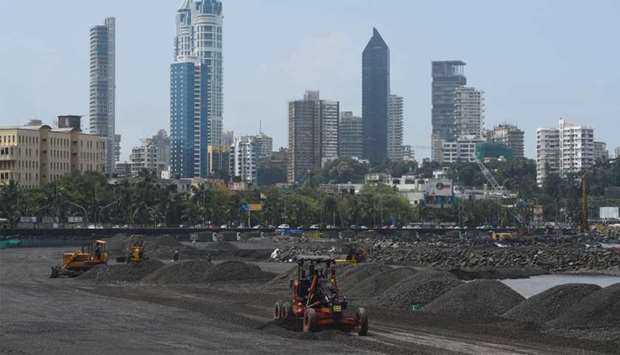India’s economy contracted by the most on record last quarter as the world’s biggest lockdown to stem the coronavirus pandemic brought key industries to a halt and rendered millions of people jobless.
Gross domestic product shrank 23.9% in the three months to June from a year earlier, the Statistics Ministry said in a report on Monday. That’s the sharpest decline since the nation started publishing quarterly figures in 1996, and was worse than any of the world’s biggest economies tracked by Bloomberg. The median estimate in a survey of economists was for an 18% contraction.
Once the world’s fastest-growing major economy, India is now on track for its first full-year contraction in more than four decades. While there are early signs that activity began picking up this quarter as lockdown restrictions were eased, the recovery is uncertain as India is quickly becoming the global epicenter for virus infections.
India reported more than 78,000 new infections on Sunday, the most by any country, with total cases nearing 4mn in a nation of 1.3bn. That could delay the consumption-driven economy from fully reopening.
“The dismal quarterly GDP print confirms the substantial cost that the harsh lockdown and lack of fiscal support inflicted on the economy,” said Priyanka Kishore, head of India and Southeast Asia economics at Oxford Economics Ltd in Singapore. “While the start of the July-September quarter has likely benefited from a post-lockdown boost, those gains are already at risk of being lost amid the ongoing pandemic and New Delhi’s hesitance to open the fiscal taps.”
The yield on India’s 10-year government bonds fell three basis points to 6.12% ahead of the data, with the securities capping their worst monthly decline in more than two years. The rupee weakened 0.3% to 73.62 per US dollar.
Details of the GDP report:
Financial services - the biggest component of India’s dominant services sector - shrank 5.3% last quarter from a year ago.
Trade, hotels, transport and communication declined 47%.
Manufacturing shrank 39.3%, while construction contracted 50.3%.
Mining output fell 23.3%, and electricity and gas dropped 7%.
Agriculture was the lone bright spot, growing at 3.4%.
A mix of monetary and fiscal measures so far to prop up the economy won’t prevent it from sliding into recession. The government has provided only limited fiscal support given constraints on revenue growth, while the central bank has cut interest rates by 115 basis points so far this year, boosted liquidity and transferredbns of rupees in dividends to the state.
A separate report on Monday showed the government already breached its full-year budget deficit target in the first four months of the fiscal year that began April 1 as revenue receipts collapsed.
Krishnamurthy Subramanian, the government’s chief economic adviser, said the quarterly slump was largely expected and due to an “exogenous shock that has been felt globally.” The economy is “experiencing a V-shaped recovery” after the lockdown eased, he said in comments distributed to reporters, adding “we should expect better performance in subsequent quarters.”
Even before the pandemic struck, Asia’s third-largest economy was in the midst of a slowdown as a crisis in the shadow bank sector hurt new loans and took a toll on consumption, which accounts for some 60% of India’s GDP. The lockdown from mid-March to contain the pandemic brought activity to a virtual halt as businesses shut down andmns of workers fled the cities for their rural homes.
The pandemic has caused historic GDP contractions in economies around the world. In India, the situation is made worse by an acceleration in virus cases, more recently in rural areas where the bulk of the population live.
The gloomy outlook puts pressure on authorities to deliver more stimulus, but there’s limited room to act. The government is facing a budget deficit of more than 7% of GDP this fiscal year, more than double its original target, while inflation is above the central bank’s 2%-6% goal, reducing the chances of more rate cuts.
Even so, Reserve Bank of India Governor Shaktikanta Das told the Financial Times that the government is set to announce more growth-supporting measures and inflation will likely ease.
Some economists expect growth to rebound to above 7% next year, mostly led by pent-up domestic demand, and a pickup in farming and exports. Yet, that’s likely to fall short of the recovery that followed the global financial crisis more than a decade ago, when growth averaged 8.2% in the two fiscal years after the crisis, boosted by massive fiscal spending, monetary easing and a swift global rebound.
“Growth recovery will also be hinged to the curb of the Covid spread and removal of even localised lockdowns,” said Suvodeep Rakshit, senior economist at Kotak Institutional Equities in Mumbai. “The choice for the government will be on whether the consumption or the investment side needs to be pushed.”

